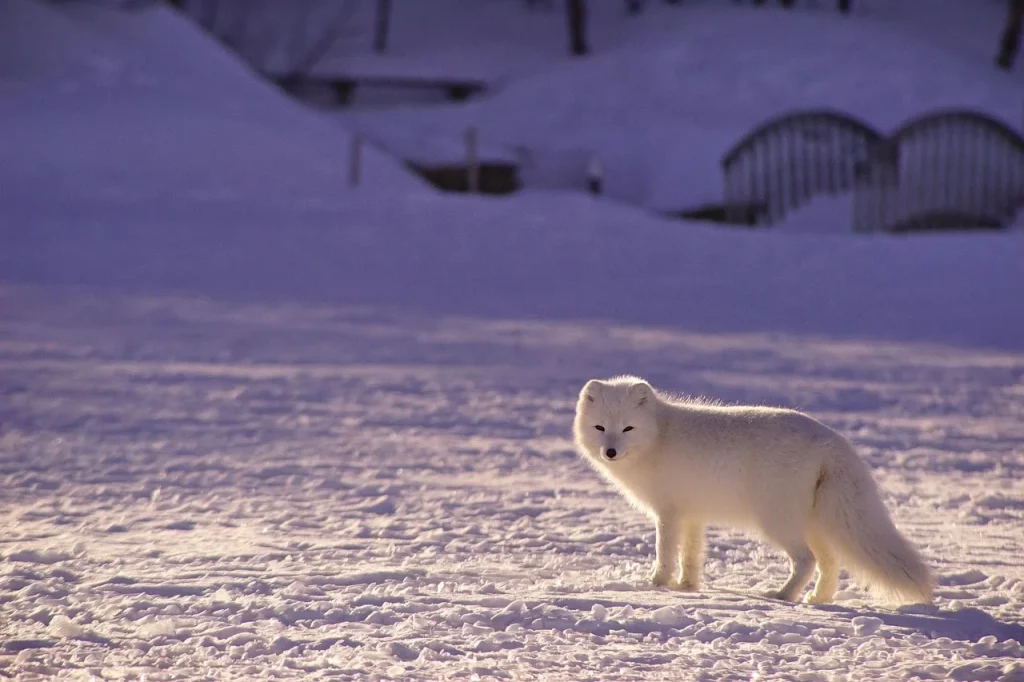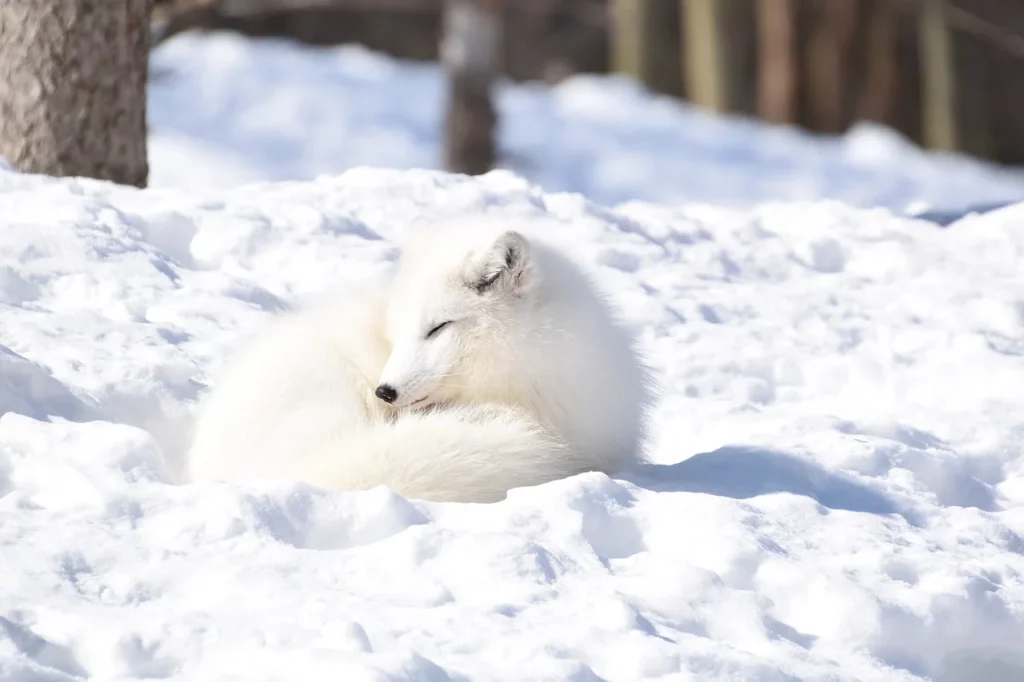Imagine a world where your biggest concern is not stepping on your own tail in the snow. Welcome to the daily life of the Arctic fox, a creature so adept at surviving the cold that it makes living in a freezer look like a tropical vacation.
These foxes are the ultimate cold-weather companions, sporting coats that change color with the seasons and using the snow as their personal playground. They’re not just about survival, though; they have a playful side, engaging in snowball fights without the snowballs.
Have you ever seen a fox make a snow angel? Me neither, but if they could, they’d probably be experts. Now, as we prepare to uncover some fascinating facts about these frosty furballs, have you ever wondered what your Arctic animal alter-ego would be? Let’s find out.
The arctic fox, with its snow-white fur, is not just surviving in the heart of winter; it’s thriving in defiance of it.
Unknown
Arctic Fox Facts
Before diving into their fascinating world, remember that a quiz awaits at the end of this page. Read carefully to prove you are worthy of having one as your pet.
- These creatures can survive extreme colds, withstanding temperatures as low as -58°F (-50°C) without shivering.
- In the summer, their coat turns to a brown or gray color, blending seamlessly with the tundra’s rock and plants.
- They are incredible hunters, capable of detecting prey under several feet of snow.
- Leaping into the air, they dive headfirst into the snow to catch their prey.
- Their diet is opportunistic, feeding on anything from small mammals to fish and even leftovers from larger predators.
- Despite their harsh environment, they have a low mortality rate in the wild, often living 3 to 4 years.
- They are solitary animals except during the mating season or when raising young.
- Adaptation to their environment includes fur-covered soles to provide warmth and traction on ice.
- They play a crucial role in their ecosystem, influencing the population dynamics of their prey.
- Their dens are complex structures with multiple entrances and can be used by several generations.
- They have a keen sense of smell, enabling them to locate carcasses buried under deep snow.
- Their white winter coat is one of the warmest furs in the animal kingdom.
- Climate change poses a significant threat to their habitat, affecting their food sources and survival.

- They are excellent swimmers, capable of crossing wide stretches of icy water in search of food.
- Their tail serves multiple purposes, including balance and warmth, wrapping around their body during sleep.
- They have a territorial range that can span over 2.5 square kilometers, depending on food availability.
- In a phenomenon known as zooplankton rain, they benefit from nutrients falling from the sea ice above.
- Their whiskers help in navigating and detecting objects in the dark Arctic winters.
- They exhibit a behavior known as cacheing, storing excess food in the ground for later.
- Mating pairs often return to the same den year after year to raise their young.
- Their paws act like snowshoes, distributing their weight to move easily across snow.
- They are indicators of environmental health, with their population changes signaling shifts in the ecosystem.
- Summer migrations can lead them to travel over 2,000 kilometers in search of food.
- Their fur is so insulative that it virtually disappears when viewed with infrared cameras.
- Able to fast for extended periods, they rely on fat reserves accumulated during the summer.
- They communicate through auditory signals, such as barks, for mating and territorial disputes.
- Global warming affects their camouflage; with snow cover decreasing, they become more visible to predators.
- Their gestation period is about 52 days, with litters ranging from 5 to 8 pups.

- They are nomadic, constantly on the move to exploit transient food resources.
- Despite their small size, they can cover distances of up to 40 kilometers in a single night.
- Their ear structure minimizes heat loss, which is crucial for survival in their frigid habitat.
- Albinism is rare but can occur, resulting in completely white individuals even in summer.
- Melanistic individuals, those with an all-black coat, have never been documented in this species.
- Their social structure during the breeding season is complex, with non-breeding individuals assisting in caring for pups.
- They can jump significant distances, aiding in their hunting strategy to break through snow to reach prey.
- Dietary flexibility allows them to survive in one of the most extreme environments on Earth.
- They have been observed using wind direction to their advantage when hunting, sneaking up on prey downwind.
- Their fur density is among the highest of any mammal, providing unmatched insulation.

- Interspecific competition for food with red foxes is increasing, with the latter encroaching on their territory due to warming climates.
- They have a unique gait, called a lope, that conserves energy over long distances.
- Their eyesight is keen, adapted to spotting prey over vast stretches of snow and ice.
- The annual molt is a critical time, as they shed their dense winter fur for a lighter summer coat.
- They are keystone species, playing a critical role in maintaining the balance of their arctic ecosystem.
- Threats include not only climate change but also diseases brought by domestic animals.
- Their reproductive success is highly dependent on the availability of prey species.
- Adaptations to a nocturnal lifestyle include highly reflective eyes that catch and utilize even the faintest light.
- They have been known to follow polar bears, scavenging leftovers from their kills.
- Despite their harsh living conditions, they exhibit playful behaviors, especially among the young.
- Their body heat regulation is so efficient that snow does not melt when it touches their fur, preventing the loss of insulating air trapped within.
- Genetic diversity within populations helps them adapt to rapidly changing environments and resist diseases.
Arctic Fox Myths

Having explored all these cool facts about arctic foxes, let’s now dive into separating myths from truths. Uncover the real stories behind the common misconceptions.
- Arctic Foxes Are Purely White
They are known for their beautiful white coats that blend seamlessly into their snowy surroundings during the winter. However, it’s a common misconception that they are always white. In reality, their fur changes color with the seasons, turning brown or gray to blend in with the summer tundra’s rocks and plants. - Arctic Foxes Hibernate During Winter
Contrary to what might be assumed, they do not hibernate. Their thick fur and unique adaptations to the cold allow them to remain active throughout the harsh winter months. They are well-equipped to hunt and survive in extremely low temperatures. - Arctic Foxes Live Solitarily
While it’s easy to think of the arctic fox as a solitary wanderer of the icy landscapes, these animals are actually quite social. During the breeding season, they are known to form monogamous pairs and live in small family groups, showing a complex social structure. - Arctic Foxes Only Eat Meat
Although they are carnivores, their diet is surprisingly versatile. It is often believed they only prey on small mammals, but in truth, they are opportunistic feeders. Their diet includes birds, eggs, and even berries and seaweed, depending on availability, showcasing their adaptability. - Arctic Foxes Are Found Only in the Arctic Region
The arctic fox is predominantly associated with the Arctic tundra and ice fields, leading to the belief that it is exclusive to this region. However, their habitat extends beyond the Arctic Circle, into alpine tundra and boreal forests, wherever they can find the cold conditions they are adapted to survive in.
No products found.
Arctic Fox FAQ

We are getting close to the final segment of our journey. But before you take the trivia test, pay close attention to the FAQ section to ensure you’re fully prepared.
- Where are Arctic foxes found?
They are native to the cold Arctic regions of the Northern Hemisphere. They are most commonly found in areas encompassing tundra, sea ice, and coastal regions in countries like Canada, Russia, Greenland, Norway, and Alaska. These little adventurers are truly built for a life amidst the ice and snow. - Can Arctic foxes climb trees?
No, they are not known to climb trees. Their physical build and habitat preferences are tailored to the flat, icy expanses of the Arctic tundra rather than forested areas. They are ground-dwellers, adept at burrowing and finding food on or under the snow. - Are Arctic foxes endangered?
Arctic foxes are not considered endangered globally and are classified as “Least Concern” by the IUCN Red List. However, certain populations, especially those in Scandinavia, face threats from habitat loss, climate change, and competition with red foxes, which can affect their numbers locally. - Can Arctic foxes swim?
Yes, they can swim, and they’re quite good at it! They are capable swimmers, which is a handy skill for crossing icy waters in search of food or new territory. Their thick fur helps them stay warm in the cold Arctic waters. - What do Arctic foxes eat?
They are omnivores with a highly adaptable diet, depending on the season. In the winter, they often feed on lemmings, Arctic hares, and carrion left by larger predators. During the summer, they diversify their diet with birds, eggs, insects, and plant material. Their ability to switch up their menu is key to surviving in their harsh environment.
Arctic Fox Trivia

Welcome to the arctic fox trivia! Ace this quiz, or you might just find your socks mysteriously filled with snow tomorrow morning.
Conclusion
These small, agile creatures, with their incredible adaptations, show us what it means to be truly in tune with one’s environment. Their survival strategies, from hunting tactics to their social behaviors, highlight the complexity and beauty of the natural world.
As we say goodbye to the icy realms of the arctic fox, let’s take a moment to appreciate the resilience of life in all its forms and the critical importance of preserving these wild spaces. Till next time, stay curious. Cheers.
3 Sources Used For This ArticleArctic Fox: Characteristics, Diet, Facts & More – Exploration Junkie
Top 10 Snow Animals and How They Survive Cold – Discover magazine


